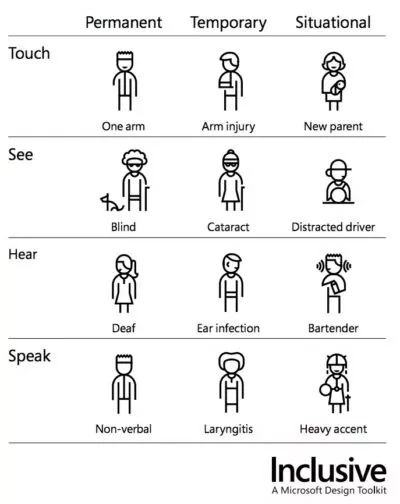11 Jul 2023
Inclusive design is driving innovation – how to stay ahead of the pack

The first blog in a series outlining the business case for inclusive design. In this blog, we will cover the mindset shifts necessary to embrace and benefit from designing inclusively.
-
Anna Boscoe
User Experience Content Specialist

Imagine being the leading organisation that provides innovative products and services that can be used by a wide range of customers in many different ways, without requiring special adaptation.
By designing in a more inclusive way you not only reap the benefits of a much wider and more diverse customer base, but you’re also doing the right thing for your company, your customers and the planet. Designing your products and services a little differently really doesn’t take radical change. It’s all about mindset and a commitment to inclusion and after all, who wouldn’t want to feel like something was designed with their specific needs in mind?
Yet somehow this simple, long-standing idea still hasn’t been universally and wholeheartedly adopted. Industries are still pumping out averagely designed products for a homogenous one size fits all customer base that no longer exists.
That is changing though and you’d best not get left behind. Inclusive design is finally gaining the traction and attention it deserves with more progressive, upwardly-mobile organisations and I’m going to explain why it should already be baked into your strategy.
What is inclusive design?
Designing inclusively means considering a range of intersecting factors such as physical capabilities, cognitive capabilities, neurodiversity, gender, sexual orientation, age, education, culture, ethnicity, legal requirements, life events, sociopolitical, and even geographic environments, each with its own complexities. Then there are systemic, structural and economic barriers that many people face. These things can be long-term or temporary and situational.
I’m not only proposing that you should consider these things – I’m also proposing that you’ll benefit from it. It’s not trivial, but it is worthwhile. In fact it’s a commercial imperative. We’ll get to that in a moment.
To keep things simple, this article focuses narrowly on physical and cognitive disabilities. In future blogs we’ll tackle a broader range of needs. So let’s get started.
Mindset shift #1: the environment is flawed, not the people
We often perceive disability as a lack of ability to do something. Here’s a better perspective: instead, someone is disabled when a mismatch exists between their abilities and their environment. From that vantage point, we could say they are dis-enabled. Happily, the environment can be improved to enable people with disabilities. And so it goes with products or services.
For example, a person with hearing difficulties can’t hear the announcements on a train, but with suitable digital signage they are no longer disabled by it.

Mindset shift #2: design with customers, not for them
To yield the rewards of inclusive design, we must work with and learn from people with a diverse range of perspectives. This could be through regular co-design sessions, user research, and fully incorporating people with differing perspectives and/or disabilities into the product team.
When Samaritans asked cxpartners to help design their first-ever chat service it was clear that the level of trust would need to be exceptional. But trust is easy to get wrong and indeed when we tested our working Samaritans prototype before it launched, it revealed a hidden problem.
We found that Samaritans’ ‘active listening’ techniques worked well on the phone, but were awkward and off-putting to chat users. You’ve probably experienced something similar using online technical support – the sense that you’re texting someone who’s not really listening to you.
By working with people who’d been in vulnerable situations, we gave Samaritans the insights needed to re-train their staff to ‘talk’ differently on chat services. Without a user-centred approach, an intervention intended to support service users may have instead increased risk of harm.
With this approach, rather than the UX practitioner being positioned as the design expert, they become the design facilitator. This can sting a bit for proud UX professionals. But customers are the experts of their own lives. Things work out better for everyone when we accept that.
Mindset shift #3: inclusive design benefits more customers than you think
Mindsets #1 and #2 are important ideas but of little consequence if you don’t have ‘permission’ to apply them. So here’s the business case.
It can be hard to persuade budget-holders that we should spend time considering how their product or service will be used by – for example – people with hearing impairments, people who use screen readers or those who have cognitive disabilities. The job is tough enough already. And conversations focus on cost because the value isn’t well understood.
It’s time to change that. Let’s put some numbers to it.
The World Health Organisation estimates that 1.3 billion people – or 1 in 6 people worldwide – experience significant disability. You could be missing out on 16% of your target market. That’s a lot of customers.
But the prize is still bigger. That’s because inclusive design leads to services that are more robust, effective and satisfying to use, and they work better for everyone.

Here are some examples:
- Some people have long-term sight loss. Many others among us experience temporary visual impairment when we forget our glasses or use a device in bright sunlight. Solutions that help one set of customers can help others too.
- Some of us have long-term motor impairments such as arthritis or cerebral palsy. Many others experience temporary motor impairments – for example if we have an arm or wrist injury or are carrying a child.
- Some of us have permanent cognitive disabilities such as Down’s syndrome or learning difficulties. Many of us experience temporary cognitive impairments and challenges when we’re tired, stressed or overwhelmed by grief, for example – all of which make information harder to process.
- In the previous example, digital signage provided for deaf people on a train also helps anyone with or without fully-working ears that misses the announcement to still get home in time for tea.

More customers. Happier customers.
We can anticipate these scenarios when we design interfaces. Many are relatively trivial to address if we just take a moment to consider them. So unlocking these benefits doesn’t require radical change, merely a different mindset.
In the next blog in this series, we will explore how to inspire your colleagues to care about designing solutions for people with atypical needs. We will provide some compelling examples of success stories, where such solutions have led to innovation and unexpected payoffs.


